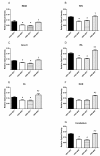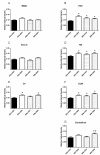Cannabinoid exposure during zebra finch sensorimotor vocal learning persistently alters expression of endocannabinoid signaling elements and acute agonist responsiveness
- PMID: 21211022
- PMCID: PMC3025904
- DOI: 10.1186/1471-2202-12-3
Cannabinoid exposure during zebra finch sensorimotor vocal learning persistently alters expression of endocannabinoid signaling elements and acute agonist responsiveness
Abstract
Background: Previously we have found that cannabinoid treatment of zebra finches during sensorimotor stages of vocal development alters song patterns produced in adulthood. Such persistently altered behavior must be attributable to changes in physiological substrates responsible for song. We are currently working to identify the nature of such physiological changes, and to understand how they contribute to altered vocal learning. One possibility is that developmental agonist exposure results in altered expression of elements of endocannabinoid signaling systems. To test this hypothesis we have studied effects of the potent cannabinoid receptor agonist WIN55212-2 (WIN) on endocannabinoid levels and densities of CB1 immunostaining in zebra finch brain.
Results: We found that late postnatal WIN treatment caused a long-term global disregulation of both levels of the endocannabinoid, 2-arachidonyl glycerol (2-AG) and densities of CB1 immunostaining across brain regions, while repeated cannabinoid treatment in adults produced few long-term changes in the endogenous cannabinoid system.
Conclusions: Our findings indicate that the zebra finch endocannabinoid system is particularly sensitive to exogenous agonist exposure during the critical period of song learning and provide insight into susceptible brain areas.
Figures




References
Publication types
MeSH terms
Substances
Grants and funding
LinkOut - more resources
Full Text Sources
Molecular Biology Databases
Miscellaneous

